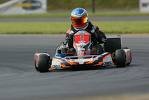I love go-karting -- indoor or outdoor, around a road course or on a short-track oval.
I've been doing it since my mate Sergio and I ran a pretty primitive go-kart that his Uncle Johnny and his father, Mario, built on an abandoned airfield strip back home in Australia in the early 1960s.
We had planned to get some experience, win some races and go open-wheel racing in Europe. We were about 14 at the time.
Well, I missed the boat when it came to Europe, heading instead in the 1970s to America, marriage, a family and writing about auto racing for a living.
Sergio's go-karting days may be a distant memory, but mine are not yet over. The truth is you can run or race a go-kart at 10 years of age or 70. (Sergio: Take note.) Yes, it's tougher on the body at 58 -- my age -- than 18. But karting is for everyone, grandpas included.
Over the years, I've practiced and raced at Kart2Kart in Sterling Heights, an indoor center, and at Jackson Speedway in Jackson, where they hold an annual 24-hour event for charity -- the Hospice 24 -- on a really neat road course linked to an oval.
I've busted a few parts -- like ribs and a knee -- but I'll put that down to brittle bones and questionable skills. Go-karting is safe despite the high speeds and acceleration of these mighty midgets.
With helmets, neck collars, gloves, driving suits and rib protectors for those who want them, a lap around a racetrack like Jackson is probably one of the safest (and most thrilling) sports a boy or girl could participate in.
I recently returned to Michiana Raceway Park, near South Bend, for a test session with some of their rental race karts. Its sister track, Rolling Green Raceway, is across the border in Buchanan, in the southwest corner of Michigan.
MRP is a 6/10th-of-a-mile asphalt road course with every conceivable turn, from high-speed to hairpin. If you can run MRP, said marketing boss and driving coach Marc Miller, you can run any go-kart track.
For starters, they have a line of what's known as Rock karts for corporate, group or private racing school use.
Rocks they aren't, as these machines are capable of 50 m.p.h., which, with your butt two inches off the ground, feels more like 80.
If that doesn't do the trick and you want to step up the pace and g-forces, try the Yamahas, which are wickedly fast (65 m.p.h.) and nimble.
It gets better at MRP, where they have Rotax karts. Driving one is like being at the wheel of a turbocharged Porsche 911. All of a sudden a surge of power kicks in and you are running 75-80.
Costs for schools and rentals vary from track to track, based on karts used. At MRP, a three-hour Rock/Yamaha driving school is $250-$300. Buying a kart can cost $5,500 or more. Jackson Speedway, where speeds and equipment are not as cutting-edge, charges adults $200 for a five-week racing league and kids $100 for a four-week driving school.
At Kart2Kart, a 20-lap session indoors is $20, while you can run a two-hour endurance race for about $80 per driver. While the course is tricky, the karts used there are slower than those at MRP and Jackson. All costs include safety equipment.
While karting isn't cheap, I've never seen a person climb out of a go-kart with a frown. It's like keeping your eyes open when you sneeze.
You can't.
by MIKE BRUDENELL
Tuesday, July 3, 2007
Kart racing can be a fun experience for all ages, skills
Posted by Ayu Chan at 3:37 PM
Subscribe to:
Post Comments (Atom)



No comments:
Post a Comment